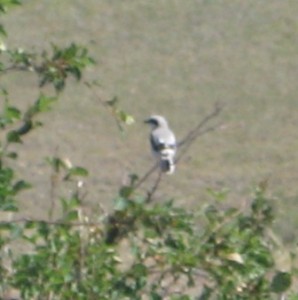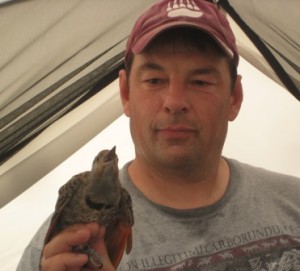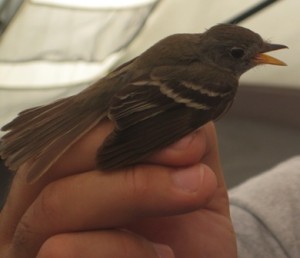Last Wednesday (8/22 to be more precise) was our second to last banding day. The Institute for Bird Populations (IBP) which is the entity overseeing all MAPS banding stations stated that in periods 8 – 10, the young of the year will predominate in the catch. What this means—or should mean—for us is that we should be catching a higher raw amount (and most likely a higher proportion) of hatchlings.
In banding session 9, however, we only caught 2 hatchlings out of 14 captures. We’ve exceeded this capture rate of young in past sessions. What is notable though is that we are starting to see different species, and particularly, different species caught that are hatchlings.
We caught our first Northern Flicker that day, and it was also a juvenile (aka hatchling, young of the year, etc). Our first capture of a juvenile Brown Thrasher also occurred on that day. Earlier in the season, the majority of the juveniles captured were House wrens, with a few Western meadowlarks, and one juvenile Eastern Kingbird. All of the aforementioned birds are smaller (especially wrens), and thus our increased capture of larger birds in general, and larger juveniles in particular, could be an artifact of a longer time requirement to maturation.
In addition, the composition of birds that we’ve observed on our censuses and caught during banding runs has gradually been changing. Early in the season we observed a fair amount of shorebirds within the Cornwell Ranch property in its entirety and within the MAPS station itself. The shorebirds have mostly moved on by this point, having begun their arduous trek to their wintering grounds. We’ve been catching more and more larger birds and fewer flycatchers, in general—the exception being the Least Flycatcher that we caught last week, which was also our first catch for that species.

A loggerhead shrike that we saw en route to our site. It was our first sighting of this species, and they are carnivorous birds that immobilize and kill their prey by slamming them onto buffaloberry spikes, fence posts, etc. In fact, the plant it is on is a buffalo berry. It has undergone drastic declines in its abundance.
We’ll keep you posted on our tenth and final banding run, and if you see a killdeer at a southerly shore nearby, please say hi to it for us!


